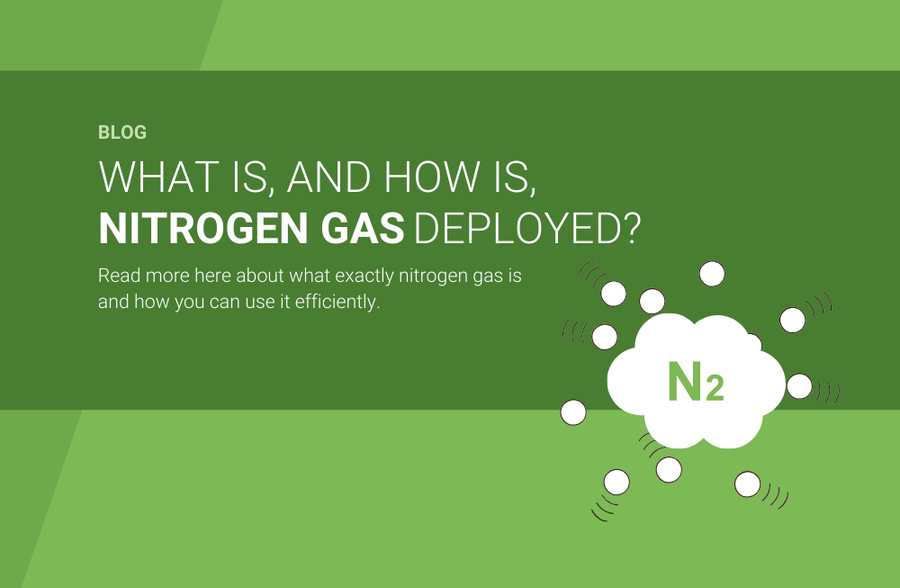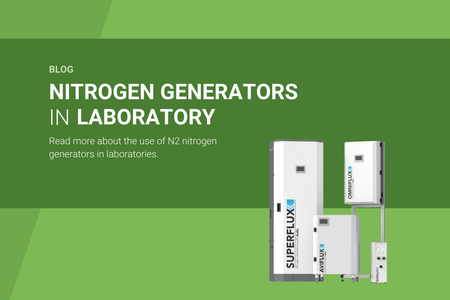
Nitrogen gas plays an important role in various industrial processes. From food packaging to chemical production and fire prevention: nitrogen gas is widely used due to its unique properties. But what exactly is nitrogen gas, why and where is it used, and how can you obtain and use it efficiently? In this blog, we take a deeper look at this topic.
What is nitrogen gas?
Nitrogen gas (N₂) is a colorless, odorless, and inert gas that makes up 78% of our atmosphere. It does not react with other substances, which makes it highly suitable for applications where oxidation or combustion is undesirable. Unlike nitrogen oxides (NOx), which contribute to environmental problems, nitrogen gas is a stable and safe gas that is widely applied in the industry.
Nitrogen gas versus liquid nitrogen
While nitrogen can exist both in gaseous and liquid states, there is a clear distinction in applications. Nitrogen gas is primarily used in industrial processes to create an oxygen-poor environment. Liquid nitrogen (-196°C), on the other hand, is used for extreme cooling and cryogenic applications, such as in the food industry and medical applications.
Avilo focuses solely on gaseous nitrogen, as nitrogen gas is the most commonly applied and efficient form for industrial processes. By generating nitrogen gas directly on-site, companies can increase safety and reduce costs without relying on liquid nitrogen deliveries. This is because on-site generators, such as membrane and PSA systems, can only produce nitrogen gas and not liquid nitrogen.
Applications of nitrogen gas
-
Fire and explosion prevention
By displacing oxygen with nitrogen gas, the risk of fire or explosions is minimized. This is especially important in sectors such as the chemical industry, pharmaceutical production, and the storage of flammable materials. -
Protection against corrosion and degradation
Many materials, such as metals and polymers, are sensitive to oxidation. Nitrogen gas is used to prevent corrosion, discoloration, and material damage, for example, during (heat) treatment of materials or the storage of chemicals. -
Food packaging and shelf life
In the food industry, nitrogen gas is used in packaging to prevent oxidation and spoilage. This extends the shelf life of products such as coffee, nuts, and fresh meat without the use of preservatives. -
Special industrial applications
Nitrogen gas is also used for:
- Inflating tires to minimize pressure loss
- Low-oxygen training for athletes
- Laboratory analysis and medical applications
How is nitrogen gas supplied?
Depending on the required amount and purity, there are several delivery methods:
- Gas cylinders: suitable for small quantities, but expensive and inconvenient due to transport and storage costs.
- Dewars and liquid nitrogen: more efficient than gas cylinders, but still reliant on external suppliers.
- Bulk storage: cost-effective for high consumption, but requires a lot of space and long-term contracts.
- On-site nitrogen gas production: the most efficient and cost-effective solution for companies needing nitrogen.
Why producing nitrogen gas on-site is the best choice
Using a nitrogen gas generator offers companies several advantages, including:
- Always available: 24/7 nitrogen supply without reliance on suppliers.
- Cost savings: no transport costs or rental contracts for storage.
- Sustainability: reduced CO₂ emissions due to the elimination of transport.
- Safety: no high-pressure cylinders or liquid nitrogen storage required.
How is nitrogen gas produced?
To generate nitrogen gas on-site, nitrogen gas generators are used. There are two common technologies:
- PSA nitrogen gas generators: This technology uses adsorptive material to remove oxygen and other gases, leaving behind nitrogen gas with high purity (up to 99.999%). This is widely used in the pharmaceutical, chemical, and food industries.
- Membrane nitrogen gas generators: Here, nitrogen gas is separated from oxygen through a semi-permeable membrane. This is an efficient and low-maintenance solution for applications where lower purity is sufficient, such as in tire inflation, fire prevention, and packaging processes.
Why produce nitrogen gas on-site?
Companies that rely on external nitrogen deliveries risk unforeseen costs and supply delays. By investing in their own nitrogen gas generator, nitrogen supply becomes more reliable and cost-effective. In addition, on-site nitrogen production provides full control over gas purity and consumption, without depending on fluctuating market prices.
Avilo specializes in on-site nitrogen gas production. Using high-quality nitrogen gas generators, we ensure an efficient and continuous nitrogen supply, allowing companies to optimize their processes and reduce costs.
Want to learn more?
Would you like to know more about how producing nitrogen gas on-site can benefit your business? Feel free to contact us or one of our specialists!
 EN
EN
 NL
NL

